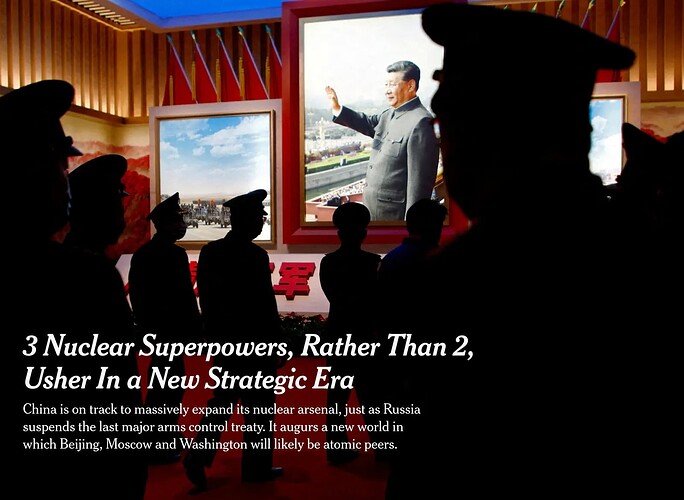-
北京正准备启动一个新的反应堆,五角大楼认为这将为中国核武库的大规模扩张提供燃料,有可能使其成为美国和俄罗斯的原子弹同行。该反应堆由俄罗斯提供,其Rosatom核工业巨头最近完成了25吨高浓缩铀的交付,以便开始生产。这一新的现实正促使人们广泛地重新思考美国的核战略,因为三个核武库的总规模可能使美国的核武库相形见绌。
-
中国坚持认为沿海的增殖反应堆将纯粹用于民用目的,而且没有证据表明中国和俄罗斯正在就武器本身进行合作,或采取协调的核战略来对抗他们共同的对手。上个月,中国国家主席习近平在莫斯科会见弗拉基米尔-V-普京总统时宣布了一项鲜为人知的消息,Rosatom和中国原子能机构签署了一项协议,将其合作延长数年,如果不是数十年。美国官员对限制中国的建设的可能性听起来几乎是宿命的。
-
剩下的一个限制美国和俄罗斯武库规模的条约–《新削减战略武器条约》在大约1000天后到期,而美国官员承认,在乌克兰战争肆虐的情况下,缔结一个新条约的可能性很小。即使俄罗斯和美国能够坐下来讨论一个条约,除非中国也签署,否则它的价值将大打折扣。北京对此没有表现出兴趣,这表明世界并没有像奥巴马总统所希望的那样朝着消除所有核武器的方向发展。
-
中国目前拥有约410枚核弹头,五角大楼预测,到本十年末,这一数字将增长到1000枚,到2035年将达到1500枚。国务院已经成立了一个专家小组,针对这种扩张提出了建议。
-
当前局势的动态比冷战时期更加复杂,当时只有美国和苏联。我们有理由对核能力的最坏情况分析持谨慎态度,因为中国和俄罗斯有着长期的不信任历史,而五角大楼也一直以夸大威胁而闻名。
-
中国核武库的扩大在国会山引起了辩论,因为一些共和党人建议扩大美国的核武库,以配合中俄联合部队。其他人称这是过度反应,跟踪核武器的哈佛大学教授马修-布恩认为,认为美国会同时打两场核战争是 “疯狂的”。
-
中国于1964年通过核试验进入核俱乐部,毛泽东采取了 "最小威慑 "战略,将武库限制在几百件武器。
-
习主席扭转了这一路线,现在专注于 “建立一个强大的战略威慑体系”,以应对其他国家的 “全面遏制”。
-
中国正在通过建造导弹发射井、后处理厂、新的反应堆以及在罗布泊核试验场的建设活动来扩大其核武器潜力。
-
中国还在发展其 "三位一体 "的核运载系统,包括用于发射导弹的新潜艇。
-
华盛顿担心习近平可能会在台湾问题的冲突中使用他的新武器。
-
专家认为,中国的增殖反应堆面临许多技术障碍。
-
中国的核扩张主要是为了塑造美国对国际力量平衡的评估,使他们接受中国将成为一个同样强大的国家这一现实。
-
可能会安装在发射井中的新型固体燃料导弹更有可能与弹头耦合,减少发射的时间。
-
中国正在消除美国心中对其威慑力的任何 “怀疑的阴影”。
-
俄罗斯和美国在高峰时拥有7万件武器,现在减少到1550件
-
拜登和普京将新的削减战略武器协议延长五年
-
俄罗斯暂停协议,仍有1550件限制
-
普京五年前展示了五类新的核武器
-
这些武器系统中只有两个取得了进展
-
俄罗斯将冷战时期的武器库升级为更具生存能力的力量
-
五角大楼认为其中一种新兴武器具有潜在的威胁性
-
拜登政府宣布计划制造冷战后的第一个新弹头
-
军备控制人员看到了移动和反移动的螺旋式上升,有可能提高误判和战争的风险
-
Beijing is preparing to start a new reactor the Pentagon sees as delivering fuel for a vast expansion of China’s nuclear arsenal, potentially making it an atomic peer of the United States and Russia. The reactor is being supplied by Russia, whose Rosatom nuclear giant has recently completed the delivery of 25 tons of highly enriched uranium to get production started. This new reality is prompting a broad rethinking of American nuclear strategy, as the combined size of the three nuclear arsenals could dwarf that of the United States.
-
China insists the breeder reactors on the coast will be purely for civilian purposes, and there is no evidence that China and Russia are working together on the weapons themselves, or a coordinated nuclear strategy to confront their common adversary. In a little-noticed announcement when President Xi Jinping of China met President Vladimir V. Putin in Moscow last month, Rosatom and the China Atomic Energy Authority signed an agreement to extend their cooperation for years, if not decades. American officials have sounded almost fatalistic about the possibility of limiting China’s buildup.
-
The one remaining treaty limiting the size of the American and Russian arsenals, New START, runs out in roughly 1,000 days, and American officials concede there is little chance of forging a new treaty while the Ukraine war rages. Even if Russia and the United States could sit down and hash one out, it would be of diminished worth unless China signed up too. Beijing has shown no interest in this, suggesting that the world is not moving towards eliminating all nuclear weapons, as President Obama had hoped.
-
China currently has approximately 410 nuclear warheads and the Pentagon predicts that number will grow to 1,000 by the end of the decade and 1,500 by 2035. The State Department has formed an expert panel to come up with recommendations in response to this expansion.
-
The dynamic of the current situation is more complicated than during the Cold War, when it was just the United States and the Soviet Union. There are reasons to be cautious of worst-case analyses of nuclear capabilities, as China and Russia have a long history of distrust and the Pentagon has been known to inflate threats.
-
The expansion of China’s arsenal has caused debate on Capitol Hill as some Republicans have suggested expanding the US nuclear arsenal to match a combined Russian-Chinese force. Others have called this an overreaction and Matthew Bunn, a Harvard professor who tracks nuclear weapons, believes it is “insane” to think the US would fight two nuclear wars at the same time.
-
China entered the nuclear club in 1964 with a nuclear test and Mao Zedong adopted “minimum deterrent” strategy, limiting the arsenal to a few hundred weapons.
-
President Xi has reversed this course and is now focused on “establishing a strong system of strategic deterrence” in response to “all-around containment” by other countries.
-
China is expanding its nuclear weapons potential by constructing missile silos, reprocessing plants, new reactors, and building activity at Lop Nor nuclear test site.
-
China is also developing its “triad” of nuclear delivery systems, including new submarines for missile launching.
-
Washington fears that Xi may use his new weapons in a conflict over Taiwan.
-
Experts believe that China’s breeder reactors face many technological hurdles.
-
China’s nuclear expansion is mostly to shape the American assessment of the international balance of power and make them accept the reality that China is set to become a similarly powerful country.
-
The new solid-fuel missiles that will probably be installed in the silos are more likely to be coupled to their warheads, reducing the time it would take to launch them.
-
China is removing any “shadow of a doubt” in the minds of the United States about its deterrent.
-
Russia and US held 70,000 weapons at peak, now down to 1,550
-
Biden and Putin extended New START accord for five years
-
Russia suspending agreement, 1,550 limit remains
-
Putin showcased five new classes of nuclear arms five years ago
-
Only two of those weapons systems have moved forward
-
Russia upgrading Cold War arsenal into far more survivable force
-
Pentagon sees one of emerging weapons as potentially threatening
-
Biden administration announced plans to make first new warhead since Cold War
-
Arms controllers see spiral of move and countermove that threatens to raise risk of miscalculation and war
